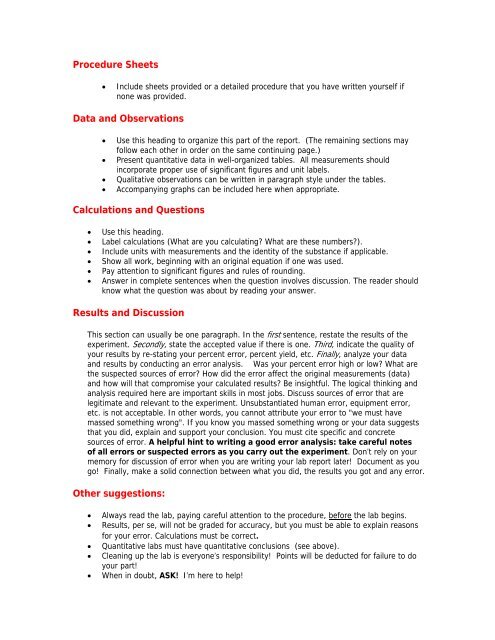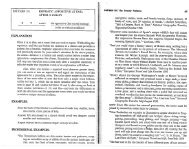Lab Report Format - Cary Academy
Lab Report Format - Cary Academy
Lab Report Format - Cary Academy
Create successful ePaper yourself
Turn your PDF publications into a flip-book with our unique Google optimized e-Paper software.
Procedure Sheets<br />
• Include sheets provided or a detailed procedure that you have written yourself if<br />
none was provided.<br />
Data and Observations<br />
• Use this heading to organize this part of the report. (The remaining sections may<br />
follow each other in order on the same continuing page.)<br />
• Present quantitative data in well-organized tables. All measurements should<br />
incorporate proper use of significant figures and unit labels.<br />
• Qualitative observations can be written in paragraph style under the tables.<br />
• Accompanying graphs can be included here when appropriate.<br />
Calculations and Questions<br />
• Use this heading.<br />
• <strong>Lab</strong>el calculations (What are you calculating? What are these numbers?).<br />
• Include units with measurements and the identity of the substance if applicable.<br />
• Show all work, beginning with an original equation if one was used.<br />
• Pay attention to significant figures and rules of rounding.<br />
• Answer in complete sentences when the question involves discussion. The reader should<br />
know what the question was about by reading your answer.<br />
Results and Discussion<br />
This section can usually be one paragraph. In the first sentence, restate the results of the<br />
experiment. Secondly, state the accepted value if there is one. Third, indicate the quality of<br />
your results by re-stating your percent error, percent yield, etc. Finally, analyze your data<br />
and results by conducting an error analysis. Was your percent error high or low? What are<br />
the suspected sources of error? How did the error affect the original measurements (data)<br />
and how will that compromise your calculated results? Be insightful. The logical thinking and<br />
analysis required here are important skills in most jobs. Discuss sources of error that are<br />
legitimate and relevant to the experiment. Unsubstantiated human error, equipment error,<br />
etc. is not acceptable. In other words, you cannot attribute your error to "we must have<br />
massed something wrong". If you know you massed something wrong or your data suggests<br />
that you did, explain and support your conclusion. You must cite specific and concrete<br />
sources of error. A helpful hint to writing a good error analysis: take careful notes<br />
of all errors or suspected errors as you carry out the experiment. Don’t rely on your<br />
memory for discussion of error when you are writing your lab report later! Document as you<br />
go! Finally, make a solid connection between what you did, the results you got and any error.<br />
Other suggestions:<br />
• Always read the lab, paying careful attention to the procedure, before the lab begins.<br />
• Results, per se, will not be graded for accuracy, but you must be able to explain reasons<br />
for your error. Calculations must be correct.<br />
• Quantitative labs must have quantitative conclusions (see above).<br />
• Cleaning up the lab is everyone’s responsibility! Points will be deducted for failure to do<br />
your part!<br />
• When in doubt, ASK! I’m here to help!



